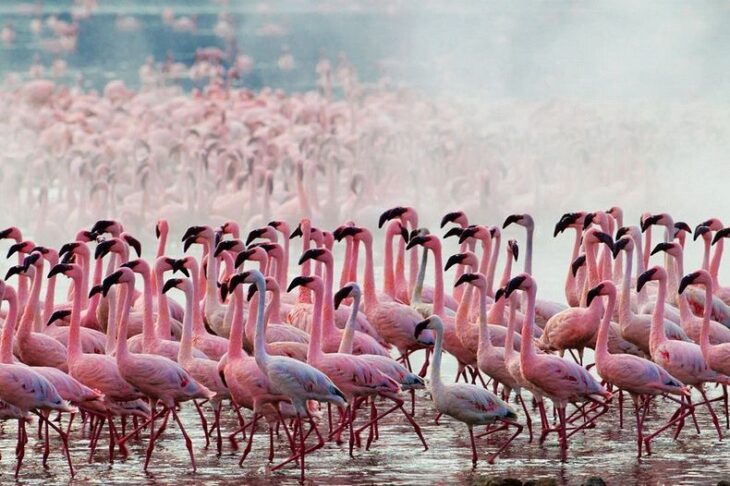NAKURU, Kenya, Sept, 27 – Researchers have warned of the presence of heavy and toxic metals in Lake Naivasha.
They have expressed concern that the water body is dying a slow death which has seen several fish species disappear and that the metals were occurring at levels above Ministry of Health’s recommended limits for drinking water.
The experts indicate that Lake Naivasha, being a freshwater lake, has pH levels of between 6 and 8, but pollution has led to acidification that has seen its pH levels drop to below 6.
They have also singled out soil erosion from the escarpments in the east of the lake’s catchment nutrient runoff and pesticide from farms as the biggest ecological threats facing the water body.
The probe established that the source of heavy metals in the lake was mostly from farming, urban effluents and beach activities.
“One other factor that could have contributed to increasing the heavy metals load is the fact that Lake Naivasha has been flooded for the last 7 years, rapidly increasing in area by about 58 per cent between 2010 and 2013 and is currently 158 square kilometres. The flooded areas are the low lying riparian land which was farmlands, public beach and sewage points,” they state in a report dubbed ‘Heavy metals in surface sediments of Lake Naivasha, Kenya: spatial distribution, source identification and ecological risk assessment’.
Kamere beach, Karagita shores, Rivers Malewa and Karati mouths, central and eastern parts of the lake, the southern shoreline, and Crescent Island were selected as sampling points for the study where total of 41 surface lake sediments samples were collected and analyzed for heavy metal concentrations at International Center for Research in Agroforestry (ICRAF) soil Laboratory in Nairobi.
The metals found in most of the sampling points include lead, zinc, chromium, iron, manganese, cobalt and iron.
“In order to safeguard human lives, hotspots of pollution should be marked for intervention even as the unpredictable phenomenon continues,” the scientists recommend.
The lake has traditionally supported local populations, tourism and a wide range of biodiversity, including waterbuck, hippos and some 350 species of water birds, hundreds of different migratory water birds, fish and plant life. It also provides an income for local fisher folk.
Currently, it is also supporting a vibrant horticultural industry, a growing population of flower farm workers, geothermal energy production, intense fishing and a runaway building boom. Flower and vegetable farms are a significant contributor to Kenya’s economy.
Highest concentrations of all the heavy metals were found in samples collected from south of the lake at Kamere beach and east at Karagita shores while lowest concentrations were reported at the north side of the Lake. Elevated levels of manganese were found in the east at Crescent Island.
Some of these heavy metals cause decreased mental, nervous system and physical development in children. In adults, it causes high blood pressure, kidney damage and reduced fertility.
49 per cent of the sediments were classified as “unpolluted to moderately polluted” for all heavy metals, except for zinc metal that was categorized as “moderately to strongly polluted”.
“Zinc threats to the aquatic ecosystem should not be ignored. Proper management plans need to be put in place; and priority areas for remediation interventions are the central portion of the lake areas, and the south and eastern shoreline that have a high level of metal pollution,” the scientists recommend.
Zinc poisoning is known to cause stomach cramps, nausea, vomiting and diarrhea.
The experts, Grace Olando from the Department of Environmental Sciences, Maseno University, Lydia A. Olaka from Department of Geology, University of Nairobi, Philip O. Okinda attached to the Department of Chemistry, Maseno University and Paul Abuom from the Department of Environmental Sciences, Maseno University warn that if this goes unmonitored, the extinction of the remaining fish species in Lake Naivasha was imminent.
The scientists note in their findings that the lake waters have been polluted by raw sewage from the sewage treatment plant, which has now been partially submerged by the swollen lake.
“The lake flooded parts of the terrestrial land around it increasing in size. The higher concentrations of heavy metals found in the northeast around river mouths and sewage point and the public beach area on southern side of the lake could be linked with the effluents from sewage and boating activities occurring in those regions,” the report indicates.
The researchers are calling for the proper maintenance of the sewage treatment works including disposal of sludge solids in ways that do not leach toxic metals into Lake Naivasha.
They also call for the controlled leaching of toxic materials from former submerged hazardous waste sites in the watershed.
According to the researchers, high concentration of lead, chromium, copper, manganese and zinc at the southern shoreline of the lake could be linked to the human activities including removal of buffering plants such as papyrus and increased cultivation of the flower farms in the area which have led to high erosion on land.
“Higher concentrations of lead, chromium and manganese metals occur on the northern side, at Malewa and Karati river mouths. This can be attributed to the inflow from the rivers and inputs from the catchment into the lake. The anthropogenic sources of zinc in the sediments can be attributed to intense boating activities along the beaches,” notes the researchers.
In 2020 National Environment Management Authority (NEMA) recommended the formation of a multi-agency team to undertake water, sediments and fish quality analysis along the lake shoreline.
They stated that the rising water levels have submerged several facilities next to the lakes which are major sources of pollution.
“In order to safeguard human lives, there is a need to conduct water and fish quality analysis even as the unpredictable phenomenon continues,” Nema stated in a report.
Want to send us a story? Contact Shahidi News Tel: +254115512797 (Mobile & WhatsApp)


